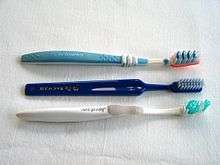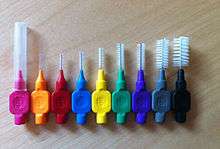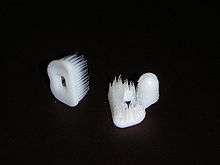Toothbrush

The toothbrush is an oral hygiene instrument used to clean the teeth, gums, and tongue. It consists of a head of tightly clustered bristles mounted on a handle which facilitates the cleaning of hard to reach areas of the mouth.
Toothbrushes are available with different bristle textures, sizes, and forms. Most dentists recommend using a soft toothbrush since hard bristled toothbrushes can damage tooth enamel and irritate the gums.[1]
History
.jpg)
Before the invention of the toothbrush a variety of oral hygiene measures had been used.[2] This has been verified by excavations in which chew sticks, tree twigs, bird feathers, animal bones and porcupine quills were recovered.
The predecessor of the toothbrush is the chew stick. Chew sticks were twigs with frayed ends used to brush the teeth[3] while the other end was used as a toothpick.[4] The earliest chew sticks were discovered in Babylonia in 3500 BC,[4] an Egyptian tomb dating from 3000 BC,[3] and mentioned in Chinese records dating from 1600 BC. The Greeks and Romans used toothpicks to clean their teeth and toothpick like twigs have been excavated in Qin Dynasty tombs.[4] Chew sticks remain common in Africa[5] the rural Southern United States[3] and in the Islamic world the use of chewing stick Miswak is considered a pious action and has been prescribed to be used before every prayer five times a day.[6] Miswaks have been used by Muslims since 7th century.
The first bristle toothbrush resembling the modern one was found in China. Used during the Tang Dynasty (619–907) it consisted of hog bristles.[7][8] The bristles were sourced from hogs living in Siberia and northern China because the colder temperatures provided firmer bristles. They were attached to a handle manufactured from bamboo or bone, forming a toothbrush.[3] In 1223 Japanese Zen master Dōgen Kigen recorded on Shōbōgenzō that he saw monks in China clean their teeth with brushes made of horsetail hairs attached to an oxbone handle. The bristle toothbrush spread to Europe, brought from China to Europe by travellers.[9] It was adopted in Europe during the 17th century.[10] The earliest identified use of the word toothbrush in English was in the autobiography of Anthony Wood who wrote in 1690 that he had bought a toothbrush from J. Barret.[11] Europeans found the hog bristle toothbrushes imported from China too firm and preferred softer bristle toothbrushes made from horsehair.[3] Mass produced toothbrushes made with horse or boar bristle continued to be imported to England from China until the mid 20th century.[2]


In Europe, William Addis (entrepreneur) of England is believed to have produced the first mass produced toothbrush in 1780.[9][12] In 1770, he had been jailed for causing a riot. while in prison he decided that using a rag with soot and salt on the teeth was ineffective and could be improved. After saving a small bone from a meal, he drilled small holes into it and tied in tufts of bristles (that he had obtained from one of the guards), passed them through the holes in the bone, and sealed with glue. After his release he became very rich after starting a business manufacturing toothbrushes. He died in 1808 leaving the business to his eldest son. It stayed in family ownership until 1996.[13] Under the name Wisdom Toothbrushes the company now manufactures 70 million toothbrushes per year in the UK.[14] By 1840 toothbrushes were being mass produced in England, France, Germany, and Japan.[15] Pig bristles were used for cheaper toothbrushes and badger hair for the more expensive ones.[15]
The first patent for a toothbrush was granted to H.N. Wadsworth in 1857 (US Patent No. 18,653) in the United States but mass production in the United States did not start until 1885. The rather advanced design had a bone handle with holes bored into it for the Siberian boar hair bristles. Unfortunately animal bristle was not an ideal material as it retained bacteria, did not dry well,and the bristles often fell out. In addition to bone, handles were made of wood or ivory.[16] In the United States, brushing teeth did not become routine until after World War II, when American soldiers had to clean their teeth daily.[12]

During the 1900s, celluloid gradually replaced bone handles.[7] Natural animal bristles were also replaced by synthetic fibers, usually nylon, by DuPont in 1938. The first nylon bristle toothbrush made with nylon yarn went on sale on February 24, 1938. The first electric toothbrush, the Broxodent, was invented in Switzerland in 1954.[17] By the turn of the 21st century nylon had come to be widely used for the bristles and the handles were usually molded from thermoplastic materials.[2]
Johnson & Johnson, a leading medical supplies firm, introduced the "Reach" toothbrush in 1977.[18] It differed from previous toothbrushes in three ways: it had an angled head, similar to dental instruments, to reach back teeth; the bristles were concentrated more closely than usual to clean each tooth of potentially cariogenic (cavity-causing) materials; and the outer bristles were longer and softer than the inner bristles to better clean between teeth. The Reach toothbrush was the first to have a specialized design intended to increase its effectiveness. Other models from other manufacturers soon followed. Each of these had unique design features intended to be more effective than the previous design.
In January 2003 the toothbrush was selected as the number one invention Americans could not live without according to the Lemelson-MIT Invention Index.[19]
Types of toothbrush
Electric toothbrush
.jpg)
It has been discovered that compared to a manual brush, the multi-directional power brush does the better job in reducing gingivitis and plaque. These brushes tend to be more costly but can be more effective in reducing plaque and gingivitis. An electric toothbrush performs rotations of its bristles and cleans hard to reach places. Most studies report a performance equal to that of a manual brush,[20] the electric version can be more comfortable. An additional timer and pressure sensors can encourage a more efficient cleaning process.[21] Electric toothbrushes can be classified, according to the speed of their movements as: standard power toothbrushes, sonic toothbrushes, or ultrasonic toothbrushes. Any electric toothbrush is technically a power toothbrush. If the motion of the toothbrush is sufficiently rapid to produce a hum in the audible frequency range (20 Hz to 20,000 Hz), it can be classified as a sonic toothbrush. Any electric toothbrush with movement faster than this limit can be classified as an ultrasonic toothbrush. Certain ultrasonic toothbrushes, such as the Megasonex and the Ultreo, have both sonic and ultrasonic movements.
Interdental brush

An interdental or interproximal ("proxy") brush is a small brush, typically disposable, either supplied with a reusable angled plastic handle or an integral handle, used for cleaning between teeth and between the wires of dental braces and the teeth.
There is evidence that after tooth brushing with a conventional tooth brush, interdental brushes remove more plaque than dental floss.[22]
The size of interdental brushes is standardized in ISO 16409.[23][24] The brush size,[25] which is a number between 0 (small space between teeth) and 8 (large space), indicates the passage hole diameter. This corresponds to the space between two teeth that is just sufficient for the brush to go through without bending the wire. The color of the brushes differs between producers. The same is the case with respect to the wire diameter.[26]
| Brush size | 0[27] | 1[28] | 2 | 3 | 4 | 5 | 6 | 7[29] | 8[29] |
|---|---|---|---|---|---|---|---|---|---|
| Passage hole diameter in mm | ≤ 0,6 | 0,7–0,8 | 0,9–1,0 | 1,1–1,2 | 1,3–1,5 | 1,6–1,8 | 1,9–2,3 | 2,4–2,8 | ≥ 2,8 |
Sulcabrush
A Sulcabrush is a type of toothbrush used specifically for cleaning along the gumline adjacent to the teeth. The bristles are usually shaped in a pointed arrow pattern to allow closer adaptation to the gums. A Sulcabrush is ideal for cleaning specific difficult-to-reach areas, such as between crowns, bridgework and crowded teeth. End-tufted brushes may also be used around fixed orthodontic appliances, such as braces.
End-tuft brush
The small round brush head comprises seven tufts of tightly packed soft nylon bristles, trimmed so the bristles in the center can reach deeper into small spaces. The brush handle is ergonomically designed for a firm grip, giving the control and precision necessary to clean where most other cleaning aids cannot reach.[30] These areas include the posterior of the wisdom teeth (third molars), orthodontic structures (braces), crowded teeth, and tooth surfaces that are next to missing teeth. It can also be used to clean areas around implants, bridges, dentures and other appliances.[31]
Chewable toothbrush

A chewable toothbrush is a miniature plastic moulded toothbrush which can be placed inside the mouth. While not commonly used they are useful to travelers and are sometimes available from bathroom vending machines. They are available in different flavors such as mint or bubblegum and should be disposed of after use. Other types of disposable toothbrushes include those that contain a small breakable plastic ball of toothpaste on the bristles, which can be used without water.
Ecological toothbrushes
Commonly, toothbrushes are made of plastic. Such brushes constitute a source of pollution.[32][33] In order to reduce the environmental impact, some manufacturers have switched to using biodegradable materials and/or use replaceable heads.[34] In order to avoid plastic altogether alternative toothbrushes on offer consist of wooden handles (often bamboo) and bristles of bamboo viscose or pig bristles.
Adversity of toothbrushes
Teeth can be damaged by several factors including poor oral hygiene, but also by wrong oral hygiene. Especially for sensitive teeth dentin and gums damages can be prevented by several measures[35] including a correct brushing technique.
It is beneficial not to scrub horizontally over the necks of teeth, pressing the brush not too hard against the teeth, not choosing a toothpaste that is too abrasive,[36] and maintain a waiting time of 30 minutes minimum after consumption of acidic food or drinks before brushing.[35][37] Harder tooth brushes reduce plaque more efficiently but are more stressful to teeth and gum, using a medium to soft tooth brush for a longer cleaning time was rated to be the best compromise between cleaning result and gum and tooth health.[38]
A study by University College London found that advice on brushing technique and frequency given by 10 national dental associations, toothpaste and toothbrush companies, and in dental textbooks was inconsistent.[39]
Hygiene and care
- It is not recommended to share toothbrushes with others since besides general hygienic concerns there is a risk of transmitting diseases that are typically transmittable by blood, such as Hepatitis C.[40]
- After use it is advisable to rinse the toothbrush with water, shake it off and let the toothbrush dry.
- Bent and worn out bristles of a toothbrush lead to decreased cleaning efficiency. It is therefore recommended to change it for a new one when it appears to be worn out (roughly after 6–16 weeks).
References
- ↑ "Oral Longevity," American Dental Association brochure (PDF), page 2 Retrieved June 12, 2008
- 1 2 3 Sammons, R. (2003). "Control of dental plaque". Medical biofilms detection, prevention and control. Chichester: John Wiley & Sons. p. 223. ISBN 978-0-471-98867-0.
- 1 2 3 4 5 Panati, Charles (2013). Extraordinary Origins of Everyday Things. HarperCollins. pp. 208–209. ISBN 978-0-06-227708-4.
- 1 2 3 Yu, Hai-Yang; Qian, Lin-Mao; Zheng, Jing (2013). Dental Biotribology. Springer. pp. 18–19. ISBN 978-1-4614-4550-0.
- ↑ salvadora persica
- ↑ IslamKotob, Muslims and Science, (Islamic Books), p.30.
- 1 2 Kumar, Jayanth V. (2011). "Oral hygiene aids". Textbook of preventive and community dentistry (2nd ed.). Elsevier. pp. 412–413. ISBN 978-81-312-2530-1.
- ↑ Harris, Norman O.; García-Godoy, Franklin, eds. (1999). Primary preventive dentistry (5th ed.). Stamford: Appleton & Lange. ISBN 978-0-8385-8129-2.
- 1 2 "Who invented the toothbrush and when was it invented?". The Library of Congress. 2007-04-04. Retrieved 2008-04-12.
- ↑ Stay, Flora Parsa (2005). The fibromyalgia dental handbook: A practical guide to maintaining peak dental health. New York: Marlowe & Company. p. 118. ISBN 978-1-56924-401-2.
- ↑ Olmert, Michael (1996). Milton's teeth & Ovid's umbrella : curiouser and curiouser adventures in history. New York: Simon & Schuster. p. 62. ISBN 0-684-80164-7.
- 1 2 Mary Bellis. "History of the Toothbrush and Toothpaste". About.com Money.
- ↑ "History of ADDIS". addis.co.uk.
- ↑ "New jobs joy in toothbrushes", cambridge-news.co.uk
- 1 2 The company founded by Addis in 1780
- ↑ "Toothbrushes - American Dental Association". ADA.org. 2010-02-04. Retrieved 2013-05-03.
- ↑ "Who invented the toothbrush and when was it? (Everyday Mysteries: Fun Science Facts from the Library of Congress)". loc.gov.
- ↑ Lazarus, George (1991-08-13). "P&G Puts Its Crest On A Toothbrush". Chicago Tribune. Chicago. Archived from the original on 2016-01-23. Retrieved 2016-01-23.
- ↑ "2003 Invention Index". 2003-01-21. Retrieved 2009-05-20.
- ↑ Deacon, SA; Glenny, AM; Deery, C; Robinson, PG; Heanue, M; Walmsley, AD; Shaw, WC (Dec 8, 2010). "Different powered toothbrushes for plaque control and gingival health.". The Cochrane database of systematic reviews. 56 (12): CD004971. doi:10.1002/14651858.CD004971.pub2. PMID 21154357.
- ↑ Kallar, S; Srivastava, N; Pandit, IK; Gugnani, N (1 January 2011). "Plaque removal efficacy of powered and manual toothbrushes under supervised and unsupervised conditions: A comparative clinical study". Journal of Indian Society of Pedodontics and Preventive Dentistry. 29 (3): 235–8. doi:10.4103/0970-4388.85832. PMID 21985880.
- ↑ Gluch, Joan I. (2012). "As an Adjunct to Tooth Brushing, Interdental Brushes (IDBs) are More Effective in Removing Plaque as Compared with Brushing Alone or the Combination Use of Tooth Brushing and Dental Floss". Journal of Evidence Based Dental Practice. 12 (2): 81–3. doi:10.1016/j.jebdp.2012.03.016. ISSN 1532-3382. PMID 22726785.
- 1 2 ISO 16409:2006 + Amd.1:2010, Dentistry - Oral hygiene products - Manual interdental brushes
- ↑ ISO/DIS 16409:2014, Dentistry - Oral hygiene products - Manual interdental brushes (draft standard)
- ↑ Different versions of the standard specify different brush sizes.
- ↑ In contrast to wrong information on several websites (as well as in old editions of Wikipedia) neither the brush color nor the wire diameter are specified in ISO 16409:2010 or ISO/DIS 16409:2014. Just some general properties of the wire (e.g., should not bend) or specifications of the packaging (e.g., the brush size must be noted) can be found there.
- ↑ Brush size 0 still can be found in ISO 16409:2010, however, it is no more specified in ISO/DIS 16409:2014 (as of December 2015).
- ↑ Brush size 1 has passage hole diameter ≤ 0,8 according to ISO/DIS 16409:2014 (as of December 2015).
- 1 2 Sizes 7 and 8 according to ISO/DIS 16409:2014 (as of December 2015).
- ↑ "GUM® End-Tuft Toothbrush - Official Site for GUM® Toothbrushes". GUM® Brand.
- ↑ "End Tuft Brush - Flossing and interdental aids". google.com.
- ↑ Cathy. "Green and Healthy Mouths- Toothbrushes". greenecoservices.com.
- ↑ Larry West. "Can You Recycle Your Toothbrush?". About.com News & Issues.
- ↑ "Building a better toothbrush - Business - The Boston Globe". BostonGlobe.com.
- 1 2 Magalhães, AC; Wiegand, A; Rios, D; Honório, HM; Buzalaf, MA (Mar–Apr 2009). "Insights into preventive measures for dental erosion.". Journal of applied oral science : revista FOB. 17 (2): 75–86. doi:10.1590/S1678-77572009000200002. ISSN 1678-7757. PMID 19274390.

- ↑ Lussic, A.; Jaeggi, T. (2008). "Erosion—diagnosis and risk factors". Clin Oral Investig. 12 (Suppl 1): 5–13. doi:10.1007/s00784-007-0179-z. PMC 2238777
 . PMID 18228059.
. PMID 18228059. 
- ↑ Cheng, R; Yang, H; Shao, M; Hu, T; Zhou, X; Zhejiang, J (2009). "Dental erosion and severe tooth decay related to soft drinks: a case report and literature review;". Univ Sci B. 10 (5): 395–399. doi:10.1631/jzus.B0820245. PMC 2676420
 . PMID 19434767.
. PMID 19434767.  "It is concluded that keeping tooth unbrushed for at least 30 min after an erosive attack is necessary for protecting dentin"
"It is concluded that keeping tooth unbrushed for at least 30 min after an erosive attack is necessary for protecting dentin" - ↑ Zimmer, S; Öztürk, M; Barthel, CR; Bizhang, M; Jordan, RA (Feb 2011). "Cleaning efficacy and soft tissue trauma after use of manual toothbrushes with different bristle stiffness". J Periodontol. 82 (2): 267–71. doi:10.1902/jop.2010.100328.

- ↑ "What's the best way to brush teeth? Even dentists and dental associations don't agree". Medical Xpress. 7 August 2014. Retrieved 8 August 2014.
- ↑ Lock, G., Dirscherl, M., Obermeier, F., Gelbmann, C. M., Hellerbrand, C., Knöll, A., Schölmerich, J. and Jilg, W. (2006), Hepatitis C – contamination of toothbrushes: myth or reality?. Journal of Viral Hepatitis, 13: 571–573. doi:10.1111/j.1365-2893.2006.00735.x
External links
| Wikimedia Commons has media related to: |
- American Dental Association statements on Toothbrushing
- BBC h2g2 The History of Toothpaste and Toothbrushes